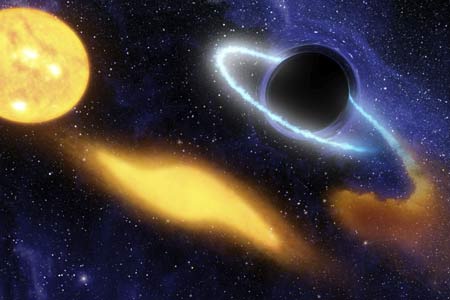 |
|
The artist's concept chronicles the star being ripped apart and swallowed by the cosmic beast over time. First, the intact sun-like star (left) ventures too close to the black hole, and its own self-gravity is overwhelmed by the black hole's gravity. The star then stretches apart (middle yellow blob) and eventually breaks into stellar crumbs, some of which swirl into the black hole (cloudy ring at right). This doomed material heats up and radiates light, including ultraviolet light, before disappearing forever into the black hole. The Galaxy Evolution Explorer was able to watch this process unfold by observing changes in ultraviolet light. The area around the black hole appears warped because the gravity of the black hole acts like a lens, twisting and distorting light.(Xinhua/Reuters Photo)
|
Scientists have found the "missing link" between small and super-massive black holes in a galaxy, according to a study published in Sept. 18 issue of journal Nature.
For the first time researchers from Durham University have discovered that a strong X-ray pulse is emitting from a giant black hole in a galaxy 500 million light years from Earth.
The pulse has been created by gas being sucked by gravity on to the black hole at the center of the REJ1034+396 galaxy.
 |
|
This composite image shows the jet from a black hole at the center of a galaxy striking the edge of another galaxy, the first time such an interaction has been found. In the image, data from several wavelengths have been combined. X-rays from Chandra (colored purple), optical and ultraviolet (UV) data from Hubble (red and orange), and radio emission from the Very Large Array (VLA) and MERLIN (blue) show how the jet from the main galaxy on the lower left is striking its companion galaxy to the upper right. The jet impacts the companion galaxy at its edge and is then disrupted and deflected, much like how a stream of water from a hose will splay out after hitting a wall at an angle.(Xinhua/Reuters Photo)
|
X-ray pulses are common among smaller black holes, but the research is the first to identify this activity in a super-massive black hole. Most galaxies, including the Milky Way, are believed to contain super-massive black holes at their centers.
The researchers say their discovery will increase the understanding of how gas behaves before falling on to a black hole as it feeds and develops.